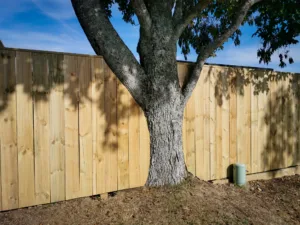A neighbour spat over trees and a dividing fence dispute that drafted not one but two Supreme Court duty judges into the the courtroom for an urgent weekend sitting has been listed for a final hearing just over three weeks after the court proceedings were filed.
Rhonda Slattery’s residential lot – in picturesque Davistown near Kincumber on the NSW Central Coast – adjoined that of 30 yr career builder David Dunn and his wife Kim Dunn.
 In discussions over the development of their site – for which they had recently gained approval – she learned the Dunns wanted to replace the existing boundary fence which had been in situ for 16 years.
In discussions over the development of their site – for which they had recently gained approval – she learned the Dunns wanted to replace the existing boundary fence which had been in situ for 16 years.
Ms Slattery floated two options for modification of the fence – part of which likely encroached on the Dunns’ land – neither of which were suitable to the Dunns.
Their proposal was to demolish the fence and rebuild a new one at their expense precisely on the common boundary and in the course of which “trim” the trunks of two paperbark trees and a concrete slab which they claimed encroached on to their land.
Slattery was concerned the proposal would imperil her trees and damage the concrete slab.
Her investigations revealed that the development consent from the NSW Central Coast Council did not provide approval for fencing work or demolition of the existing boundary fence.
Her anxiety escalated to alarm when she received a letter from the Dunns on Saturday 7 October notifying her they intended to commence boundary fence demolition works at 7.00am on the coming Monday.
Her response was to prepare paperwork for an urgent court application and drive to Sydney the following morning to open up the Supreme Court registry to file it and to find a judge to make orders to prevent the demolition.
Ms Slattery swore in her affidavit that the application needed to be dealt with urgently because – among other issues – she had two large dogs that need to be confined.
Siting in the Land and Environment Court, Justice Moore indicated he would grant the temporary injunctions to the self-represented – provided she gave the “usual undertaking”, ie to compensate the Dunns for losses suffered if their position prevailed over hers at the final hearing – restraining the Dunns from interfering with either of the paperback trees or demolishing any part of the concrete slab.
The application to restrain the demolition of the dividing fence was though – in his view – outside the jurisdiction of that court.
He therefore transferred the proceedings to the weekend Supreme Court equity judge, Justice Trish Henry, who considered the fence application later that Sunday also on an ex parte basis.
Ms Slattery was – after having been again called on to give the “usual undertaking” and again obliging by giving it – granted her the stop-demolition injunction which she was ordered to serve on the Dunns before 8pm that night.
The matter came before Justice Henry again two days later when she transferred it back to the Land and Environment Court thereby conferring on it the jurisdiction to deal the dividing fence issue which it had initially lacked.
When the matter came before Justice Sarah Prichard in the Land and Environment Court on 12 October, Ms Slattery was represented by counsel. Mr and Mrs Dunn were self-represented but were armed with an arborists report and a survey plan to prove the alleged encroachments and the suitability of the proposed trimming of the paperbark trees’ trunks.
The judge referred the matter for an on-site mediation and listed it for a further directions hearing on 18 October indicating it would be then listed for final hearing if not resolved. The injunctions were extended once again as were Ms Slattery’s undertakings.
The parties participated in the mediation but that proved unsuccessful and when the matter was next dealt with on 18 October, Ms Slattery appeared by telephone from the Central Coast, self-represented.
Justice Pritchard expressed her consternation that the matter hadn’t been resolved and warned them of the consequences of adverse costs orders and in Ms Slattery’s case, the risk of having to pay compensation by reason of her undertaking.
When Ms Slattery informed the judge that she didn’t understand the obligations comprised by the “usual undertaking”, the term was explained to her in some detail prompting the response “Yes, I do” to the judge’s “Do you now understand ?”
The matter was listed for a final hearing on 2 November but there is no record of a court determination on that date.
This may suggest that the parties – when faced with the risk of adverse costs orders and in Ms Slattery’s case the undertaking risks – may have resolved the dispute among themselves with a modicum of common sense.
Slattery v Dunn [2023] NSWLEC 107 Pritchard J, 18 October 2023 Read case




0 Comments